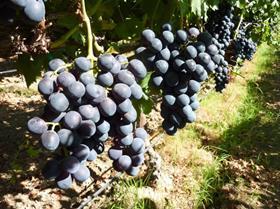
From Mexico to Washington State, fruit production has been running well behind schedule so far in 2010. Mexican grapes from Sonora got off to a very slow start, while the Northwest cherry deal struggled to get enough product to supply the 4 July holiday demand. In California’s San Joaquin Valley, the stonefruit harvest has also sputtered during the first several weeks of its season. So why should California’s San Joaquin Valley table grape season be any different? Answer: It’s not. The culprit bedevilling all of these deals has been the weather: An unusually cool and often rainy spring in the San Joaquin Valley is resulting in one of the latest seasonal starts in years.
“It was obvious early on that the season would be getting off to a late start this year,” said Michael Little of Vincent B Zaninovich & Sons. “We `as an industry` just didn’t think it would be this late.”
The consensus among California’s table grape experts is that the new season has been delayed by as much as two weeks.
“It’s all weather-related,” said a philosophical John Harley of Anthony Vineyards, usually one of the industry’s earliest grower-shippers to begin packing each year. “People forget that it was raining here every other week during April. Last year, `the first shipments from` Arvin started around 23 June. This year, the deal was scratching the surface as of 12 July.”
Even as daily temperatures in the Southern San Joaquin Valley began to return to seasonal norms in mid-July, soaring above 100°F (38°C), the California industry was still struggling to come up with container-load volume for Asian export markets due to lagging sugar levels. With shipments from both the Coachella Valley and Mexico rapidly winding down, FOB prices were on the rise, especially for top-quality white grapes.
“They’ve got a red-hot Sugraone `Superior Seedless` market to start the San Joaquin deal this year,” one major exporter of table grapes told Fruitnet.com. “There is very little top-quality fruit available from either Coachella or Mexico now, so companies with any volume `of Sugraone` are seeing some pretty good money. That will change very soon, however, as there is a lot of fruit hanging on the vines this year.”
Last April, the California Table Grape Commission issued a pre-season forecast of 97.1m carton (19lb; 8.6kg) equivalents. Most industry experts agree that, barring an extended summer heat wave or an early onset of the rainy season in the fall, the San Joaquin Valley table grape crop will likely top the 100m carton mark. If so, it would be an industry record, surpassing the 99.1m cartons shipped in 2008. The industry appears confident that it can move such an enormous crop at profitable levels for their growers, as long as they have a quality product to sell. As the season got underway, the major concern was irregular berry sizing that was pervasive across all the early varieties – a direct result of the cool, wet spring weather.
“I’m not worried about the eating quality once the fruit is ready `for packing`,” said Mr Little. “The mixed berry sizing may be a challenge for the industry, but that’s just a fact of life for this year’s crop.”
The late start to the season has already caused industry concern over its ability to adequately supply fruit for one of the major annual Chinese holidays – the Moon Festival. Californian table grape growers count on Moon Festival demand to help move major volumes of table grapes each season. While seedless varieties continue to grow in consumer popularity throughout Asia, Red Globes remain the traditional varietal favourite for the holiday. Unless fruit maturity unexpectedly accelerates during late July and early August, most industry observers anticipate Red Globes to be in relatively short supply for the Moon Festival this year.
“The first Red Globes of the season typically come off the vines by the third week of July each year,” said Mr Harley. “At this point, it looks like the industry won’t get going on Globes until the first week of August. If that trend continues, it will likely push a lot of export product well into September.”
The varietal mix of table grapes from California is expected to continue to evolve during 2010 as more acreage of late-maturing, better-colouring seedless varieties reach commercial bearing levels. Summer Royal – a black grape with high sugar levels – is expected to be available in significant quantities for the first time this season and is expected to pave the way for its later-maturing cousin, the popular Autumn Royal. For a mid-season red grape, the Scarlet Royal is expected to gain market share against the dominant but finicky-colouring Crimson Seedless.
The other newcomer on the California scene is the Autumn King, which is being counted on to fill the industry’s long-standing need for a hardy, good-eating late-season white grape as an alternative to cartons of 16lb (7.3kg) Thompson Seedless placed in storage, or the seeded Calmeria.
“Both Autumn Royal and Scarlet Royal have helped grow demand for black and red grapes in Asia,” said Nick Dulcich of Sunlight International Sales. “Crimson Seedless have had some quality issues during the last couple of seasons and that has opened the door for Scarlet Royals to gain some acceptance. Singapore, Thailand and Malaysia are all taking good quantities of Scarlet Royals now.”
“South East Asia does seem to be embracing Scarlet Royals more than China and Hong Kong have so far,” agreed Mr Harley.
“The ‘storage’ Thompson Seedless is rapidly going out of style in favour of the Autumn King variety,” said Brian Crettol of Jasmine Vineyards. “I think you’ll see Thompsons revert back to their natural market window of August and September and sold fresh, while acreage of Calmerias will continued to get pulled.”
“Autumn King has the potential to change the entire profile of the late-season table grape deal from California,” said Mr Little.



